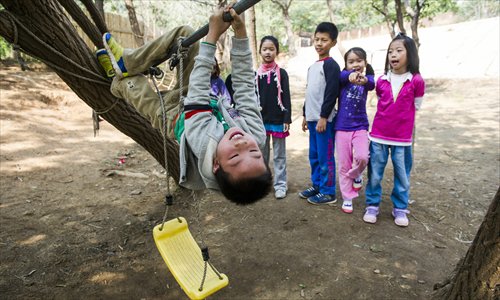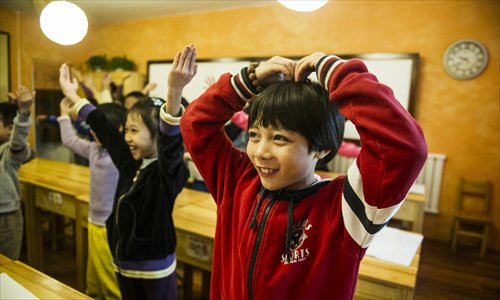

Students monkey around in the playground at the Spring Valley Waldorf School. Photo: Li Hao/GT

Students at the school contort themselves into different poses as part of an exercise for learning pinyin. Photo: Li Hao/GT
A radically humanistic approach to pedagogy is gaining a following in China
The first thing that one notices upon entering a classroom at the Spring Valley Waldorf School is that there are no textbooks.
There are no long multiplication tables, or standardized learning diagrams pinned to any of the powdery pink walls. The only materials that record what has been taught are made by students themselves, in large robust scrapbooks.
There are no set curriculums. No standardized tests. No grades. Just groups of contented children, gently guided along by a teacher, to sing, dance, paint, mould, sculpt, dig, weave, build, knit, plant, play, and learn.
Tucked away in the mountains on the outskirts of Beijing's Haidian district, the school is one of more than 300 preschools and elementary schools following a radically alternative approach to education known as the Waldorf method.
Developed by Austrian philosopher and educator Rudolf Steiner in the first two decades of the 20th century, the Waldorf approach emphasizes the role of imagination in learning.
Lessons, particularly at the preschool and early elementary levels, are primarily hands-on and sensory-based.
Rather than memorizing times tables by rote, multiplication is learned through games which require students to perform certain actions with their bodies on multiples of a particular number. Rather than simply reading about folk stories, students are asked to perform them in classroom theatrical productions. Rather than copying diagrams about photosynthesis, students are taken into the hills to dig up the earth, and plant seeds.
The goal, according to Waldorf educators, is to cultivate a love of learning, and to develop free-thinking, morally responsible and socially engaged individuals.
In search of an alternative
"I grew up under the traditional education system and I didn't want my daughter to follow the same path. Chasing after the highest grades and cramming information by rote won't help her in her later life," said Xu Ping, 42, who enrolled her daughter at the Spring Valley Waldorf School last April.
Prior to enrolling at the school, Xu's daughter attended a kindergarten that followed the Montessori educational approach, which likewise emphasized exploratory, hands-on learning that gives students a large amount of freedom. But as the kindergarten did not offer elementary education, Xu decided to enroll her daughter at the Spring Valley Waldorf School.
"Many parents think that Waldorf education is still at the experimental stage in China, and do not want to risk to sending their children there," said Xu.
"But I didn't want my daughter to simply be an obedient child, as she would have been taught to be in a traditional school. I want her to grow into an adult with a strong will and a clear understanding of the world."
"Waldorf education has a long history in Western countries. After learning about it through a series of workshops, I believed it was suitable for her," said Xu.
Transferring to the school was not a simple process. Located more than two hours' drive from the center of Beijing, Xu had to make the difficult decision to relocate the family somewhere closer.
As part of the school's admissions policy, Xu also had to agree to being interviewed by a panel of the school's administrators, to ensure that she understood and agreed with the school's teaching philosophies. The school requires parents to be intimately involved in their child's education, and periodically runs workshops for parents and their children.
"When new students first arrive, it sometimes takes them a while to let go of their old habits of simply being obedient and passive," said Yu Ningyuan, director of the Spring Valley Waldorf School. "But later, they start to relax and will feel a sense of relief."
Founded in 2011, the school currently has around 100 students from preschool through to elementary school grade four. The classrooms are divided into two rows of idyllic red-brick buildings, with ample wooden verandahs. The school grounds also include an organic farm, where students learn basic agricultural skills.
"Every day, the children can hear birds singing and insects chirping. During recesses, they can play in the sand and the dirt. They breathe along with nature," said Wang Shoumao, a teacher of the fourth-grade class at the school.
"[We've] strived to cultivate a natural environment for the children, so it's a little bit like having a rural education."
Asian students drive US education reform
2014-09-25Chinese education in eyes of US teachers
2014-09-16Govt vows to work toward equality in education
2014-09-05Importance of physical education
2014-08-05Copyright ©1999-2018
Chinanews.com. All rights reserved.
Reproduction in whole or in part without permission is prohibited.